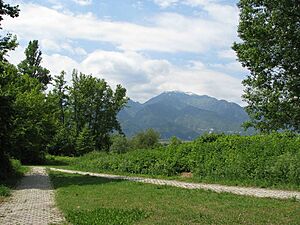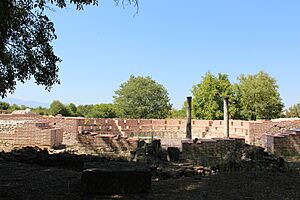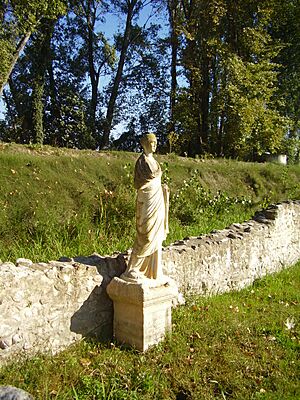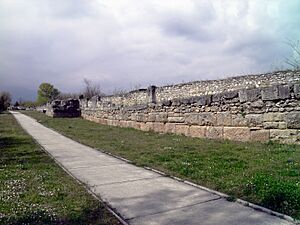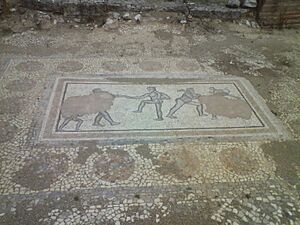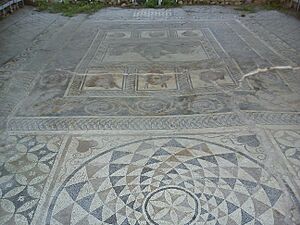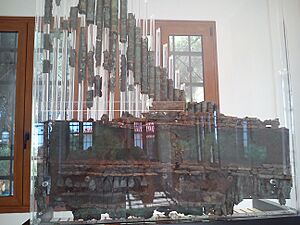Dion, Pieria facts for kids
Quick facts for kids
Dion
Δίον
|
|
|---|---|
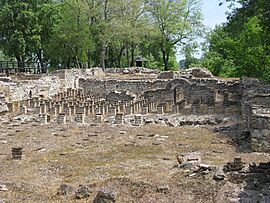
Hypocaust of ancient public baths
|
|
| Country | Greece |
| Administrative region | Central Macedonia |
| Regional unit | Pieria |
| Municipality | Dio-Olympos |
| • Municipal unit | 172.743 km2 (66.696 sq mi) |
| Elevation | 40 m (130 ft) |
| Population
(2021)
|
|
| • Municipal unit | 9,067 |
| • Municipal unit density | 52.4884/km2 (135.944/sq mi) |
| Community | |
| • Population | 1,268 (2021) |
| • Area (km2) | 31.375 |
| Time zone | UTC+2 (EET) |
| • Summer (DST) | UTC+3 (EEST) |
| Postal code |
601 00
|
| Area code(s) | 23510 |
| Vehicle registration | KN |
Dion (pronounced Dee-on) is a village and a municipal unit in Greece. It sits right at the foot of the famous Mount Olympus. This area is part of the Pieria region.
Dion is most famous for its incredible ancient Macedonian sanctuary. This special place was dedicated to Zeus, the king of the gods. There's also an ancient city here. You can explore much of it at the Archaeological Park of Dion and learn more at the Archaeological Museum of Dion.
Contents
History of Dion
The name Dion comes from "Dios," which means "of Zeus." This shows how important Zeus was to this place. It was a very sacred spot for the ancient Macedonians. They believed Zeus and the Muses (goddesses of arts and sciences) lived on Mount Olympus nearby.
For a long time, people worshipped Zeus and the Muses here. They built a large altar in a beautiful area with many trees and springs. This made Dion the "sacred place" of the Ancient Macedonians. Kings would offer sacrifices here to celebrate the new year. They also held special ceremonies to purify the army and celebrate victories.
The first time Dion is mentioned in history was in 424 BC. The Spartan general Brasidas passed through Dion on his way to fight the Athenians. Later, around the end of the 5th century BC, King Archelaus I made Dion even more important. He started a nine-day festival with games and competitions. These events honored Zeus and the Muses. The Macedonian kings themselves helped organize these big festivals.
Both Philip II and his son Alexander the Great celebrated their victories in Dion. Alexander even gathered his armies here. He performed grand sacrifices before starting his famous journey to Asia in 334 BC.
Ancient writers also talk about a famous bronze sculpture by Lysippos. It showed 25 mounted companions who died in the Battle of the Granicus. This artwork was later taken to Rome.
A city was built next to the sacred sites. It became very grand during the time of Alexander's successors. Cassander helped build strong walls and public buildings. Because of this, Dion was known for its strong defenses and beautiful monuments.
In 219 BC, invaders destroyed Dion and its sanctuary. But King Philip V quickly rebuilt it. Many important items from the destroyed sanctuary were buried. These included royal writings and treaties. Archaeologists have found these items recently.
The Romans took over Dion in 169 BC. The city became important again around 32/31 BC. This is when Octavian founded a Roman colony there. Coins from this Roman colony still exist today. Dion had another golden age in the 2nd and 3rd centuries AD. Roman emperors who admired Alexander the Great liked the city. Dion's last important period was in the 4th and 5th centuries AD. It became the home of a bishop. Eventually, major earthquakes and floods caused the city to be abandoned.
The modern village at this site was called Malathria until 1961. Then, it was officially renamed Dion.
Archaeological Discoveries
The ancient site of Dion was first found by an English traveler, William Martin Leake, in 1806. He saw the ruins near the village of Malathria. Later, Léon Heuzey visited the site in 1855 and 1861.
Serious archaeological digs didn't start until 1928. From 1928 to 1931, G. Sotiriadis found a 4th-century BC Macedonian tomb. He also uncovered an early Christian church. Excavations began again in 1960. Since 1973, Professor Dimitrios Pandermalis has led the archaeological research in the city.
Dion has a large temple dedicated to Zeus. There are also several temples dedicated to Demeter and Isis. Isis was an Egyptian goddess who was a favorite of Alexander the Great.
Archaeologists found a magnificent building called the House of Dionysos. Inside, they discovered an incredibly detailed mosaic floor.
A very rare find in the museum is a bronze "hydraulis." This was a type of hydraulic musical pipe organ. It was found in an old workshop.
In 2006, a statue of Hera was found built into the city walls. This 2200-year-old statue had been used by early Christians in Dion. They used it as part of the city's defensive wall.
How Dion is Governed
In 1992, the Municipality of Dion was created. In 1997, it grew bigger by adding several nearby communities. The main office was in the village of Kondariotissa.
In 2011, Greece changed how its local governments worked. Dion joined with other areas to form the new municipality of Dion-Olympos. Dion became a "municipal unit" within this new, larger municipality. The community of Dion includes the village of Dion and Platanakia.
Population Over Time
| Year | Community population | Municipal unit population |
|---|---|---|
| 1981 | 1,236 | - |
| 1991 | 1,149 | 9,876 |
| 2001 | 1,314 | 10,885 |
| 2011 | 1,424 | 10,066 |
| 2021 | 1,268 | 9,067 |
Gallery
-
Shields dedicated by Alexander the Great after his victory.
See also
 In Spanish: Díon para niños
In Spanish: Díon para niños



